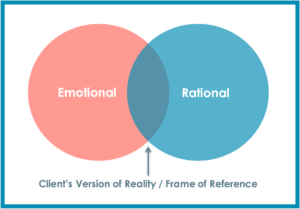 One of the most challenging tasks for a financial planner is designing an effective discovery process that truly engages their clients’ hearts and minds, while also providing valuable insights about each person’s frame of reference.
One of the most challenging tasks for a financial planner is designing an effective discovery process that truly engages their clients’ hearts and minds, while also providing valuable insights about each person’s frame of reference.
At Money Quotient, we believe the place to start is by recognizing that each client operates with two minds: the rational mind and the emotional mind. These two minds do to not work independently of one another, but continually interact and influence what the individual thinks, feels, and believes.
This interplay is shown in the diagram by the area in the middle where the two circles overlap—this represents each client’s version of reality or frame of reference. In our Money Quotient training course, we refer to this intersection as the “sweet spot” for getting to know and understand your clients. Each person’s version of reality is unique and highly influential in forming perceptions, evaluating choices, and making decisions. Therefore, as a trusted financial professional, it should be your goal to get in touch with each client’s version of reality as quickly and as efficiently as possible.
...it should be your goal to get in touch with each client’s version of reality as quickly and as efficiently as possible. Click To TweetWhy is this so important? Frames most often operate in what the scientists call the “cognitive unconscious,” or more commonly known as blind spots. Therefore, helping your clients to “see” their frames will be the first step in helping them to make positive change. In the context of a financial planning relationship, the goal is to help your clients be more intentional about making financial decisions that align with their values and support their life goals.
Keep in mind that this new awareness seldom requires therapy in the traditional sense, but rather occurs when facilitating a process that poses effective questions and fosters thoughtful reflection. I believe this is the true meaning of “discovery,” and it will lead to positive and proactive client conversations.
In addition, the key to unlocking your client’s frame of reference is employing “empathic listening.” The late Stephen Covey called this the most important communication skill of all, and devoted a whole chapter in the 7 habits of Highly Effective People to explaining the nuances and benefits of of this practice. In a nutshell, he exhorts us to “seek first to understand, and then to be understood.”
However, Covey also warns that we can’t develop empathy by learning and applying communication techniques alone—the most important ingredient is intention:
In empathic listening, you listen with your ears, but also, and more importantly, listen with your eyes and with your heart. You listen for feeling, for meaning. You listen for behavior. You use your right brain as well as your left. You sense, you intuit, you feel. .…You’re listening to understand.
-Carol Anderson

I love this! When you listen – really listen – to a client. It’s magic. They love it and you find out what is most important to them. That makes your recommendations easy for them to implement.
Thanks for your comment, Joan. I agree, it is like magic!! 🙂
Thank you for add some dimension to the “discovery” meeting. I have been having many conversations on discovery meetings lately. Discussions are all very process oriented and seem to leave the client and purpose out of the conversation. I am looking forward to the training in February where I hope to learn how to do a better job of integrating structured process and empathetic listening.
Many thanks, Adrienne! We look forward to having you join us in Portland for the February training!